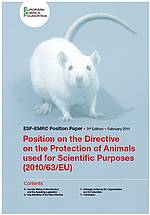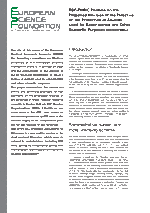Chair
Professor Roger Lemon, University College London, London (UK)
3rd Edition: Current Status of the Directive and the Resulting Legislation
The Directive has now been finalised and published in the Official Journal of the European Union, and has entered into force as EU law. Member States must now, within two years, pass (or amend existing) national legislation to make the provisions of the Directive legally binding. Subsequently, the Directive will enter into force in Member States in January 2013 and existing legislation is expected to rmain in place until that time.
The Directive sets objectives and minimum common standards, which Member States must transpose into national law. It is binding as to the result to be achieved, although the annexes can be amended through comitology (this committee system is both a political and technical process which oversees the delegated acts implemented by the European Commission).
The articles of the Directive specify the legal requirements. However, the choice of form and methods to achieve those requirements are left to the national authorities. Member States are not free to apply more stringent national measures to this specific legislation, but can maintain more stringent measures that are already in place if they are for the protection of animals.
1st and 2nd Editions: Abstract
Unless it is amended, the new EU Directive on the Protection of Animals used for Scientific Purposes, as proposed by European Commission and European Parliament, could seriously impede the further advancement of European medical and veterinary research. The Directive requires amendments and further reinforcement of the fundamental principles applied to the use of animals in scientific research. These conclusions were published in two position papers from the European Medical Research Councils (MED (formerly EMRC)), the Standing Committee for Medical Sciences at the European Science Foundation (ESF).
- ESF-MED (formerly EMRC) Position on the Proposed Revision of the Directive on the Protection of Animals used for Experimental and other Scientific Purposes - 1st Edition 12 September 2008
- ESF-MED (formerly EMRC) Position on the Proposal for a Directive on the Protection of Animals used for Scientific Purposes - 2nd Edition 24 March 2009
This latter position paper also has the support of the Champalimaud Foundation, EUROHORCs, Foundation for Polish Science, the Pasteur Institute and the Wellcome Trust.
The paper presents a consensus on the subject reached within the European medical research community, drawing on the conclusions of the high-level Expert Group of European scientists chaired by Professor Roger Lemon and coordinated by the ESF-MED (formerly EMRC), and summarising the policy of ESF’s Member Organisations. It aims to provide input into the discussion on the revision of the existing EC Directive on the protection of animals used in scientific research (86/609/EEC).
According to Professor Roger Lemon “The new European Directive on animal testing should employ more clearly the fundamental guiding principles for the use of animals in medical research, thereby ensuring an appropriate level of protection of animals used for scientific purposes, including non-human primates, while at the same time allowing for continued progress in scientific research”.
In particular, three main themes run through the conclusions of the Expert Group:
- The overarching significance of the 3Rs in animal testing as a guiding principle – Refinement of scientific techniques, Reduction in numbers of animal used, and Replacement of animal procedures with non-animal procedures. As a complementary measure to the implementation of the Directive, the Expert Group emphasizes the need of properly funded 3Rs led-research programmes initiated or enhanced by the EU Member States and European Commission.
- The importance of the harm-benefit analysis for each prospective project involving animals in research and coupling this to the improvement of animal welfare to the highest level compatible with the scientific objectives of the project.
- The need of efficient decision making with the minimum bureaucracy in implementation of the Directive, including defined time limits for licensing of research by the permanent ethical review body and the competent authority.




